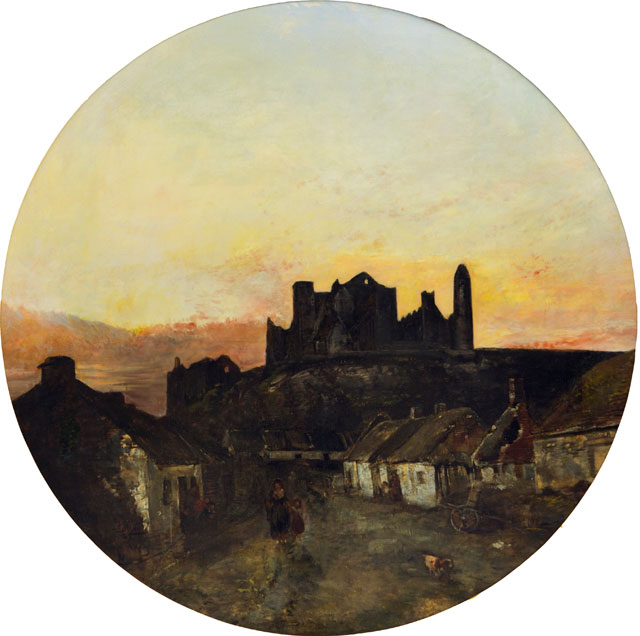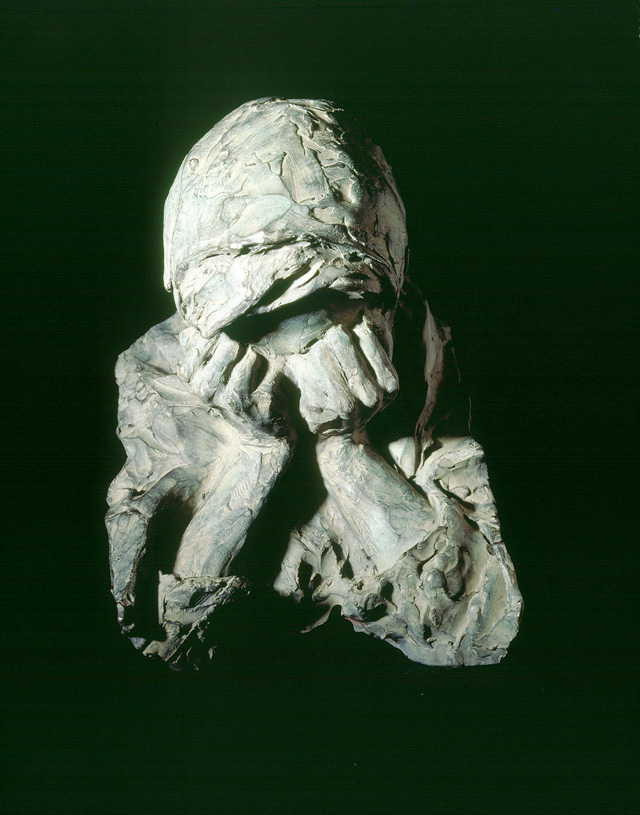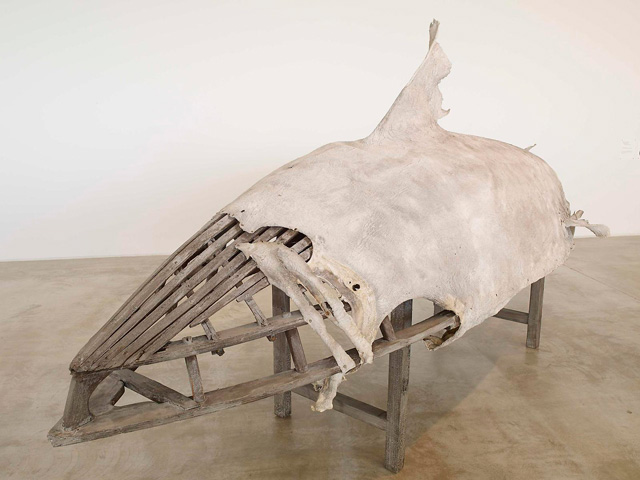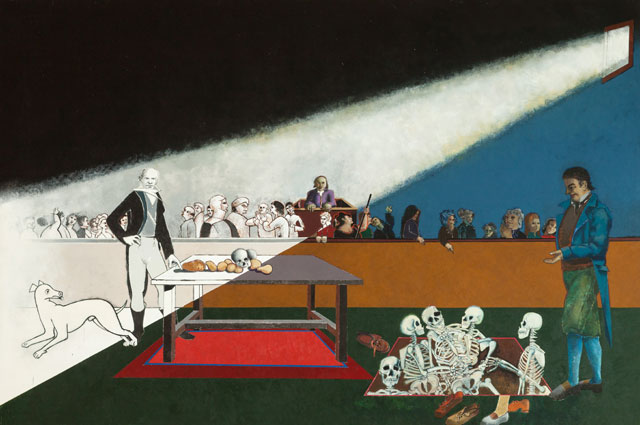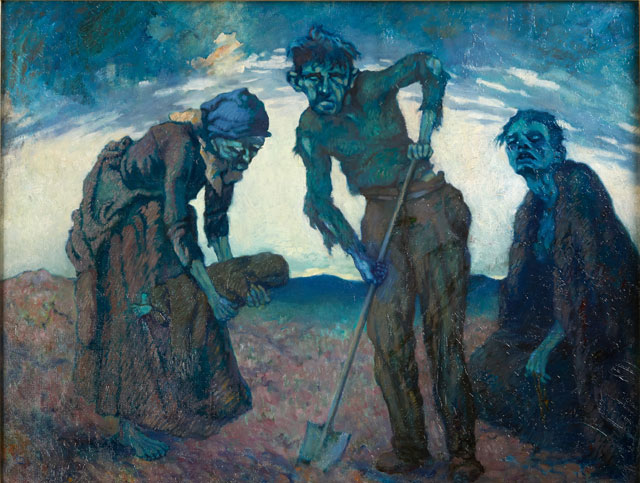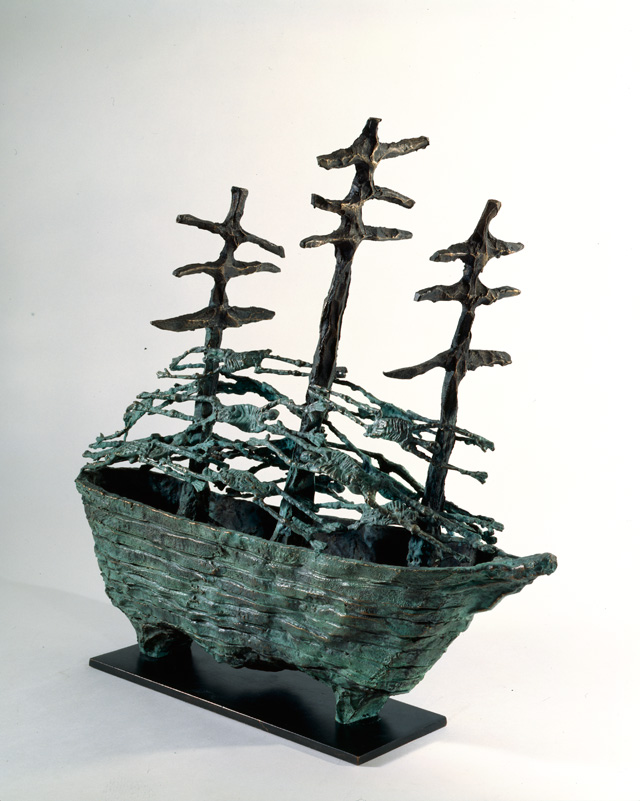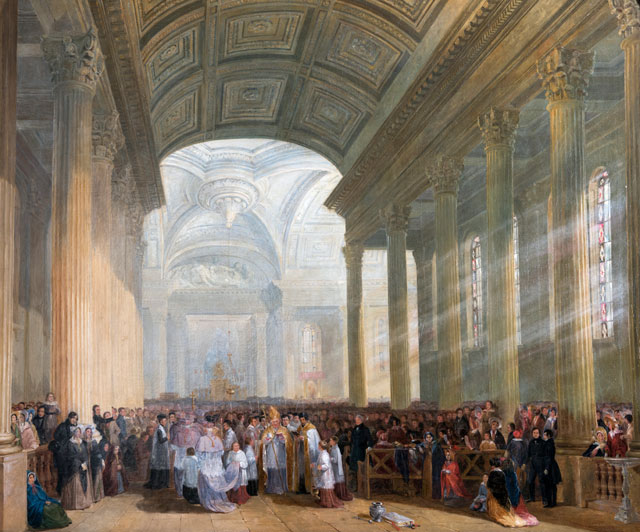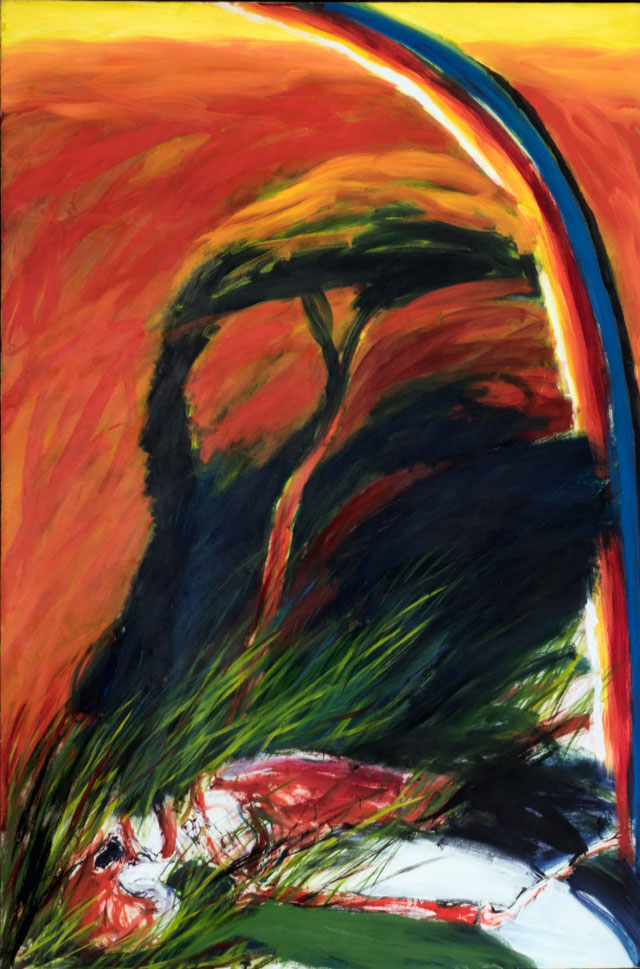

Cultúrlann Uí Chanáin, Derry
18 January 2019 – 16 March 2019
by JANET McKENZIE
The exhibition Coming Home: Art and the Great Hunger presents historical and contemporary artists’ responses to the most calamitous episode of Irish history. The Great Hunger (1845-52) was the worst demographic disaster of 19th-century Europe. The art in the exhibition, dating from the 1830s to the present day, by some of the most esteemed Irish and Irish-American artists, reveals the extent to which the trauma and loss have been erased from history. It also shows the need to memorialise and to remember the event, and to acknowledge the impact on individual lives and the extent of cultural loss that ensued. The poignant show opens in Derry this month, following successful runs last year at the Coach House, Dublin Castle, and at West Cork Arts Centre in Skibbereen, which together attracted 85,000 visitors.
Coming Home is the product of dedicated scholarship in America and Ireland and it is a revelation. The documentary video that accompanies the exhibition presents evidence that, in the 19th century, the Irish were considered to be less valuable than African slaves; in Skibbereen, a local woman next to me exclaimed: “It’s still in our heads.” Observing the extent to which the great tragedy in Irish history continues to affect individuals and the collective psyche more than 150 years later is deeply affecting.
[image5]
In his foreword to the scholarly catalogue that accompanies the exhibition from Ireland’s Great Hunger Museum at Quinnipiac University in the US, Michael Higgins, the President of Ireland observed: “For a very long time it was something to which we could not give a name. It was something with which we were not able to engage. It was something that generated a great silence. There can be no doubting, however, that An Gorta Mór was a defining moment in the history of modern Ireland and a turning point in the history of our people. The exodus from our shores during that period was unprecedented in Irish history and our rising population fell by 2.5 million as a result of death and mass emigration.”
The great famine took place against the context of empire and elitist land ownership, of appalling poverty; eviction from their lands and starvation were among the shocking consequences. Coming Home highlights the power and poignancy of images made by visual artists historically and more recently by contemporary artists who have chosen to address the loss and dislocation experienced by descendants in Ireland and the vast Irish diaspora worldwide. New scholarship has evolved that enables a clearer understanding of the tragic chapter of Ireland’s history. A visual dialogue runs parallel to documented history to enable viewers to identify with a wordless account of their tragic past. Art and artistic practice in Coming Home is conceived as an integral tool of the healing process (art as prosthetic memory). The art on show indicates how art can often reveal emotional content to a personal/political experience that verbal statements may not (art as political witness). Coming Home is publicising to a far wider audience than conventional gallery attendees the momentous events of the past and providing examples of contemporary responses, thus offering a path to the resolution of historic loss.
[image7]
Ireland’s Great Hunger Museum in the United States was conceived in 1997, the year that marked the 150th anniversary of the Irish Famine by John L Lahey, who is now the president of Quinnipiac University and chairman of the board of the museum. It opened in 2012 and houses the world’s largest collection of the Great Famine-related art. Curator Niamh O’Sullivan, together with Ireland’s Great Hunger Institute at the university, has presented a valuable body of recent scholarship in the catalogue that accompanies the show. Coming Home is an important act of cultural reconnection with Ireland’s past and living diaspora. For visitors from other countries, it is an exhibition of huge importance and from an art-historical perspective it raises many issues.
Tracing the visual response to a calamity on the scale of the Irish famine raises far-reaching aesthetic and ethical questions. When Daniel Macdonald (1820-53) exhibited Irish Peasant Family Discovering the Blight of their Store (1847), in England, he employed a spirited realism informed by Honoré Daumier or Jean-François Millet. The skilful representation of hardship, based on extensive knowledge and observation created a poignant account of Irish suffering. Following the Acts of Union 1801, there was an exodus of the art-purchasing class from Ireland and, consequently, relatively few artists lived and worked in Ireland during the famine. The Victorian taste for history painting could not pictorialise the epic catastrophe of the famine. History painting drew on morally uplifting narratives – mythological slayings, religious crusades and the great battles of Empire. They were created with the distance of time. It was not morally acceptable to draw children or entire families dying in Great Britain. The realistic portrayal of corpses from starvation would have implied criticism of government. History painting, by contrast, was intended to commemorate the past rather than provide a documentary account of contemporary events. Further, the purchasing classes would not have chosen the horror of emaciated bodies and rotting potatoes for their homes. It was not until the 20th century that visual styles developed that could convey the horrific truth.
The famine coincided with the birth of mass-produced newspapers. The Illustrated London News, established in 1842, was circulated in Britain and America. It carried 32 engraving in each weekly issue. It has been estimated that, with sales and further readership, as many as three million readers learned of the devastating situation in Ireland. Still, restraint and decorum prevailed. Academy-trained artists learned from the antique, physiologically quite different to the stunted corpse-like victims of starvation. Racial stereotyping emerged in the comic magazine Punch that led authorities to blame the Irish for famine-related problems; colonial policy was pitifully out of touch. The artists and illustrators could not go to Ireland and draw reality any more than they could imagine the scale and intensity of the suffering. In 1847, artist James Mahony wrote: “Neither pen nor pencil could ever portray the misery and horror.”
[image4]
Twentieth-century artists have sought to reconcile the scarcity of material evidence to address their own histories with inherited trauma. One of the most searing, visual responses, was created by Michael Farrell (1940-2000). An outspoken political artist, he focused on the failure of the British government to address the famine. For Black ’47, the artist studied photographs of Holocaust victims at Auschwitz. He also drew inspiration from Gustave Courbet’s Burial at Ornans (1849-50), a contemporaneous work. Referring to his famine paintings and the Bloody Sunday series, he stated: “The potato was only an excuse to get rid of us and get the land”; and quoting George Bernard Shaw: “It was not a famine – it was organised starvation.”
[image2]
The narrative sculptures of American artist Glenna Goodacre (b1939) evoke the profound suffering of her forebears. As winner of the highly contested Irish Famine Memorial (2003) in Philadelphia, she created a 450-piece bronze sculpture that included 35 life-sized figures in a park that overlooks the Delaware river where so many Irish disembarked.
[image8]
William Crozier (1930-2011) was born in Glasgow to an Irish Scottish family. After studying at the Glasgow School of Art he went to London and Paris. In the mid-50s, he lived in Dublin and was involved in literary circles there. His Skeleton painting series from 1969 was a response to visiting the concentration camps of Auschwitz and Bergen-Belsen. Later, he gave vent to his horror by addressing the tragedy of Irish history, the two world wars and the Holocaust. When British troops entered Northern Ireland in 1969, Crozier relinquished his British passport and became an Irish citizen. The retrospective exhibition in 2017 at Uil linn: West Cork Arts Centre and at the Irish Museum of Modern Art, sought to place Crozier as one of the most important artists of his generation. His powerful expressionistic works, in his own words, “convey a sense of austerity and isolation, of emotional unease and perhaps a sense of tragedy”.
Robert Ballagh (b1943) adapted pop art to Ireland. His work draws on a wide range of art-historical references. Trained as an architect and a musician, Ballagh also works in stage design. Keen to demystify art, he depicted himself in conversation with Johannes Vermeer, Hans Holbein, Diego Velázquez, Laurence Sterne, James Joyce and Joseph Sheridan Le Fanu. During the Troubles, his work assumed a political character, exposing injustice and oppression. Ballagh highlights the inheritance of the famine as unfinished business. He describes his narrative triptych, An Gorta Mór:
“I elected to underscore the piece with a clear and simple narrative. On the left side of the triptych the potato plant is flourishing while on the right side it has been afflicted by blight. The potato barely sustained a peasant population in Ireland, living in frugal conditions – this is represented on the left-hand panel – however, when the potato crop failed, catastrophe followed. The population was halved by starvation, disease and emigration. The right-hand panel represents an eviction scene, where starving tenants, unable to pay their rents, have been evicted; their homes pulled down and thus ‘encouraged’ to emigrate. A soldier is included in this sorry scene to underline the failure of the authorities to adequately respond to the needs of the people. Finally, a ship ‘lies waiting in the bay’, to take the fleeing emigrants to foreign shores where the Irish story continues …”
[image6]
The arresting bronze sculpture Famine Ship (2000), by John Behan (b1938), captures the horror of the journey made by hundreds of thousands of Irish to America and Australia. Many of the passengers were so emaciated and weak before boarding that they did not survive the journey. He explains: “My art is related to ancient culture as well as to modern technique. I feel that every artist or sculptor or painter, must have roots, roots that will tap into the ground. It’s not to say that you don’t live in the modern world – I use all of the technology I possibly can to express myself – but in terms of Irish art, we have had a gap between the middle ages and the 20th century – so I had to go back: the future was in the past, if you like.”
Famine Ship is an iteration of the National Famine Memorial (1997) in County Mayo. It is a site of annual pilgrimage. Famine Ship represents the “coffin ships” depicted with corpses in a horizontal pattern. The three masts form an image that resonates with the crosses at Calvary, the Holy Trinity. When the dedication ceremony took place, representatives from 14 nations attended. Britain was conspicuous by its absence.
[image3]
Dorothy Cross (b1956) represented Ireland at the Venice Biennale in 1993. Her art practice employs sculpture, photography and video. She now lives in Connemara, looking over the sea where she dives for wreckage and found objects that she uses to create sculptures that represent a dialogue with the past, creation and destruction. Basking Shark Currach (2013) dominates the exhibition space. An aesthetic of growth and decay conjures pain and time. Informed by Jungian archetypes and the conceptual artist Joseph Beuys, Cross’s work combines repulsive and ironic strains. Drawing on Irish culture, the Currach is a handmade wooden boat over which animal skins are stretched. It has been used in the west of Ireland for centuries.
She says: “I am very interested in what is repulsive and what is beautiful, because in our own bodies we are so confused about that, in terms of sexuality and our own mortality. The shark epitomises that, too, in terms of fear and desire and misunderstanding. In Basking Shark Currach, the combination of a mysterious animal, generally feared, and the ribs of a small boat have formed a life-saving relationship. The dorsal fin of the shark reads like the keel of the boat, which is the structure that balances the vessel as it moves through the water.”
Coming Home is replete with heartfelt responses to the historic calamity. The exhibition is also intended to raise awareness of the famines that still occur around the world and the necessity of addressing historic erasure.
All artist quotes are from Coming Home: Art and the Great Hunger, edited by Niamh O’Sullivan, Ireland’s Great Hunger Museum, Quinnipiac University Press, Hamden, Connecticut, 2017.
